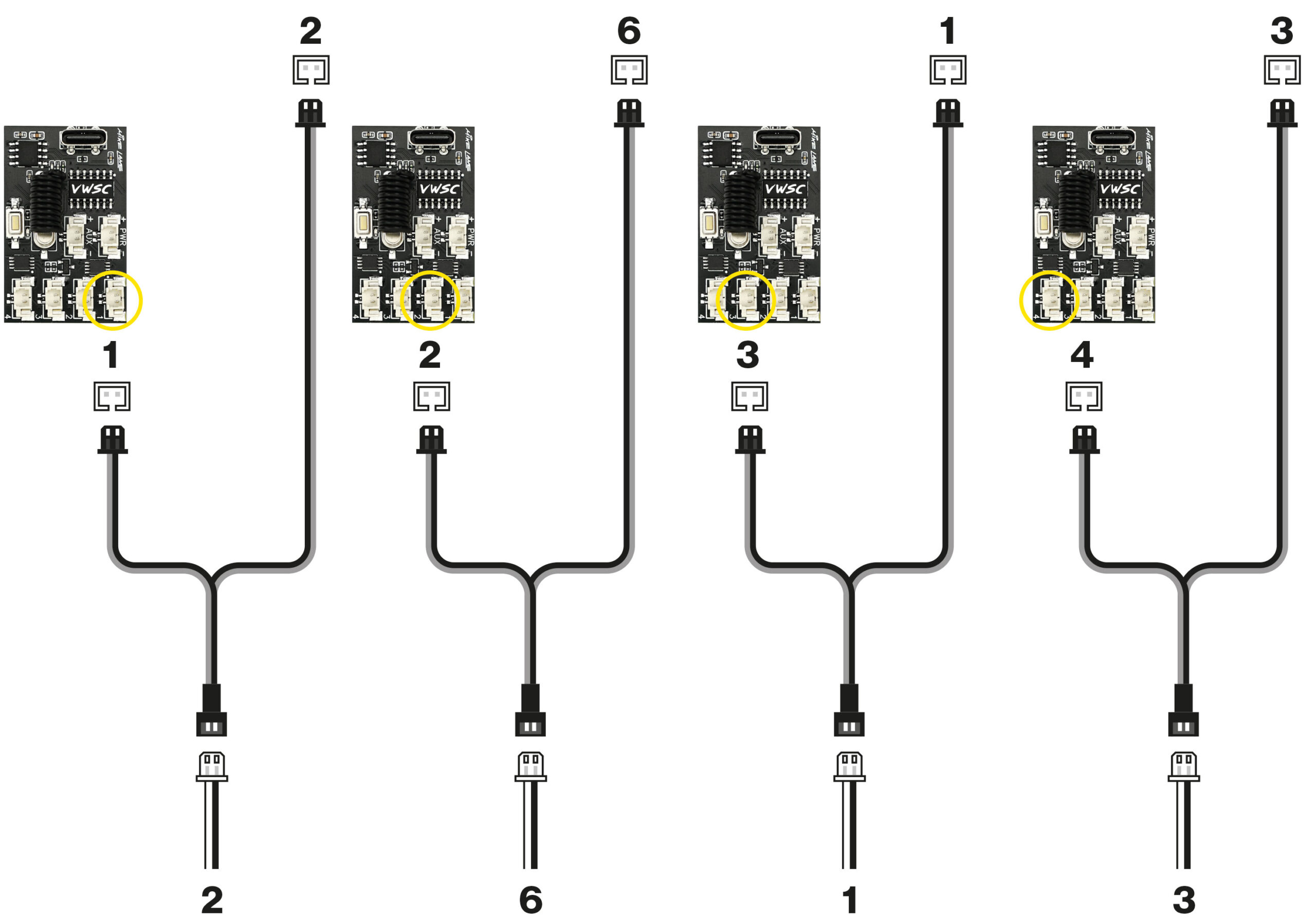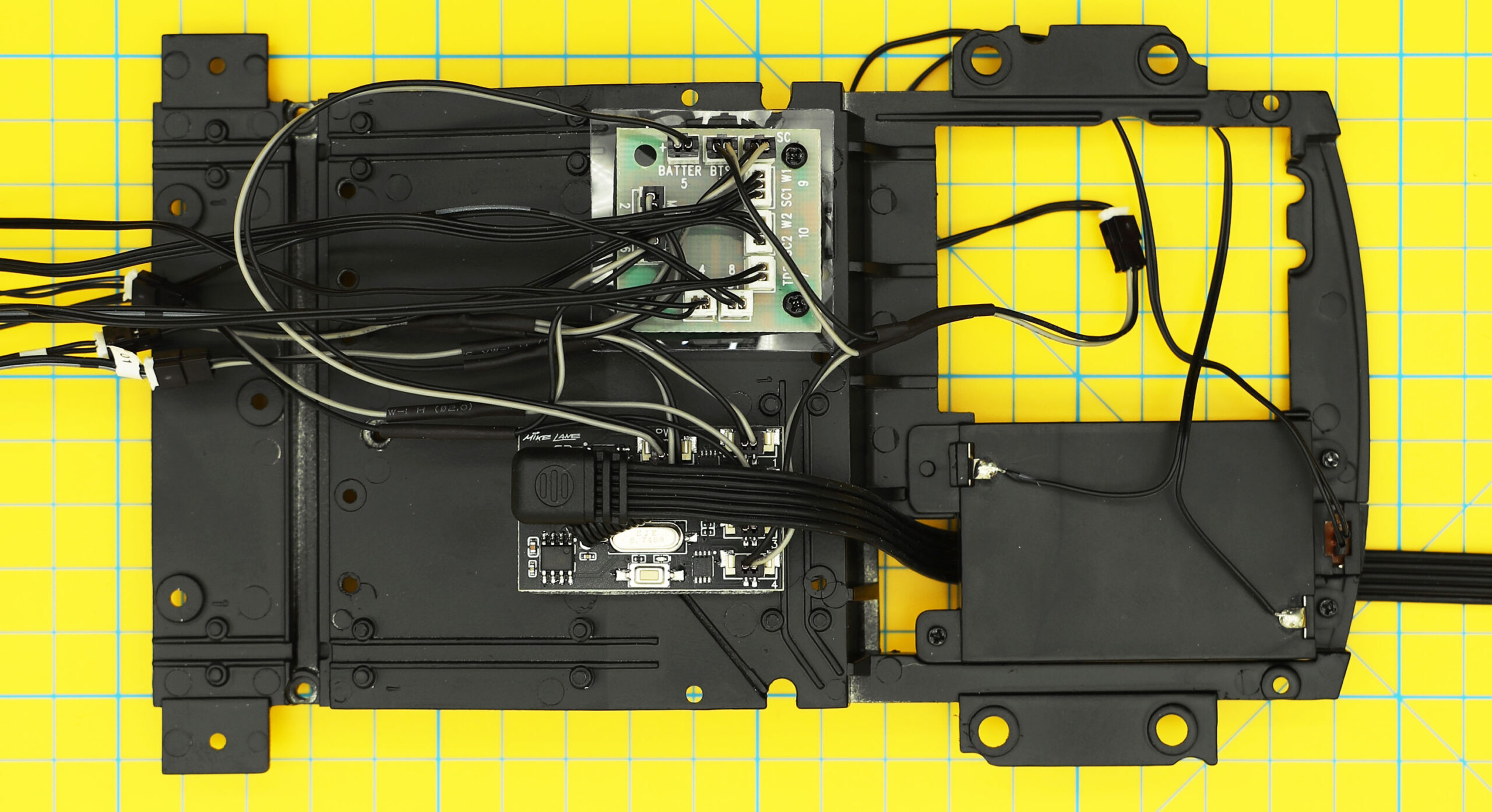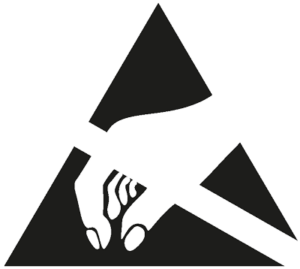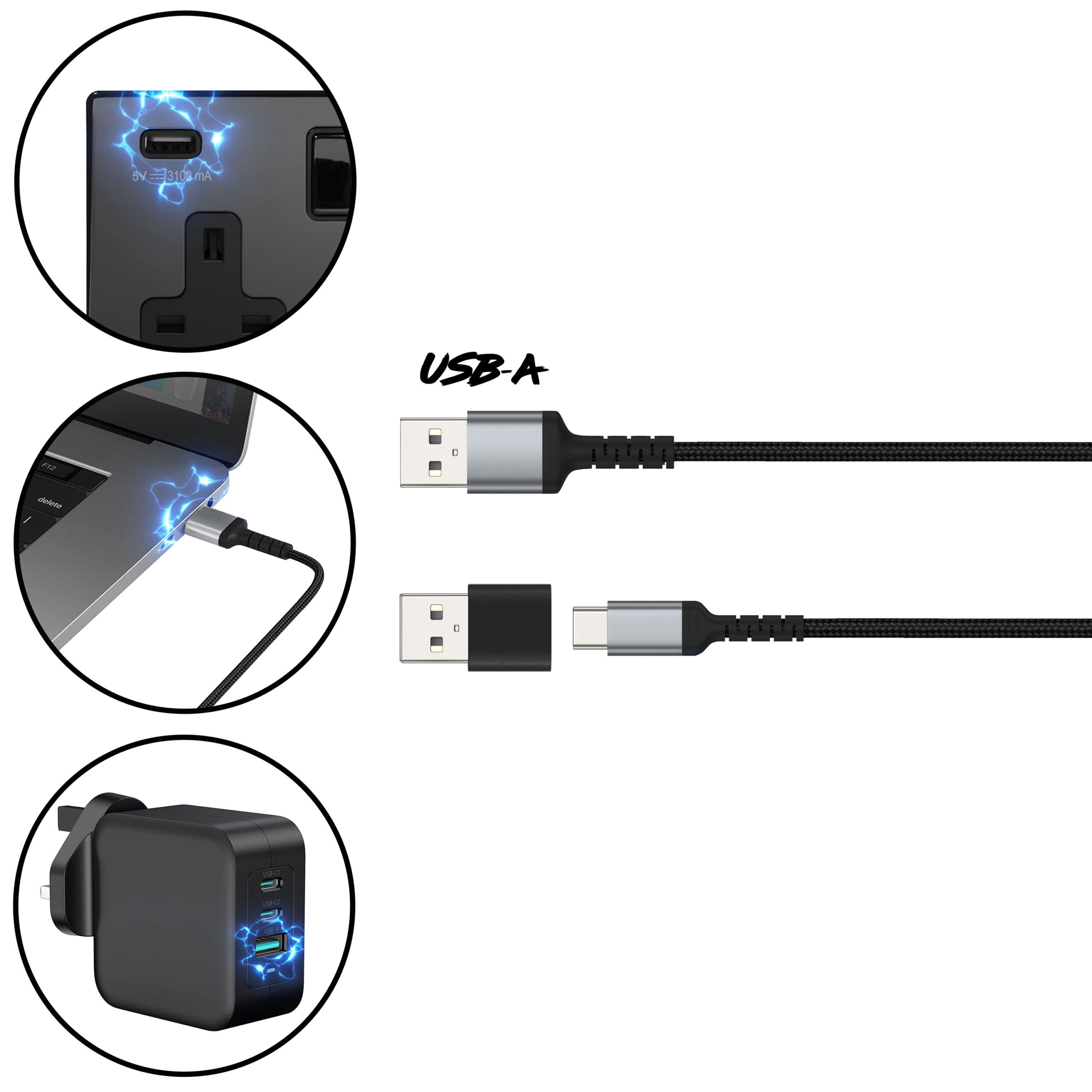Designed for Pack 8 (Stage 75) of the Build the T1 Samba Camper by DeAgostini/Altaya.
The simple rule
Stick to USB-A for safe, stable 5V power.
Only use direct USB-C if you know the adaptor outputs a fixed 5V.
You can power your model using any standard USB-A power sources, including:
In-wall USB sockets rated at 5V (e.g. 5V 3.1A/3100mA is ideal)
USB ports on laptops, PCs or Macs (most supply a fixed 5V)
USB power banks with a fixed 5V output
Powered USB hubs that provide a fixed 5V output
Or a dedicated USB power adaptor:
Mains power adaptors with USB-A port that provide a fixed 5V output
If your kit includes only a USB-C cable, you’ll need either:
- a dedicated 5V 2A USB-C power adaptor, or
- a USB-C to USB-A adaptor to connect to standard USB-A sockets (such as those found in wall outlets, PCs, or USB power adaptors).
Never attempt to power the model via any other method, including:
Third-party power mods or alternative power sources.
Multiple power mods at once
This product is a complete power mod solution. Connecting more than one power mod together is dangerous and may cause serious damage or fire risk. If another mod is already installed, remove and fully disconnect it before starting.
The existing battery box or batteries.
This power mod replaces the battery system entirely. Connecting both may cause malfunction or damage..
Fast chargers, smart chargers, or variable-voltage adaptors when using USB-C
If connecting directly using USB-C, avoid using adaptors with technologies such as USB Power Delivery (PD), Quick Charge or Fast Charge, which can output higher voltages (e.g. 9V, 12V, 20V). If proper voltage negotiation doesn’t occur, the adaptor could deliver too much power and damage the circuit. Using USB-A sockets however is usually safe and they almost always output a fixed 5V, which makes them much safer for your power mods.
Technical information
This product requires a stable 5V (max) 2A (min) power supply to function reliably.
To clarify:
- 5V is the maximum voltage — anything higher may damage the product.
- 2A is the minimum current — higher current (e.g. 3.1A/3100mA) is perfectly fine. The device will only draw what it needs.
So, for example, a wall socket with USB-A connection rated 5V 3.1A is ideal and completely safe to use.
- Connect the USB-C cable to the Mike Lane Remote Control circuit board and plug in to a power source, such as a power bank, laptop, or USB-C adaptor.
- The blue LED on the Mike Lane Remote Control circuit board will light up dimly and extinguish after 10 seconds.
- Single press the programming button on the Mike Lane Remote Control circuit board.
- The blue led on the circuit board will flash to indicate that the board is ready to receive remote codes.
- Now press the buttons numbered 1-4 on the remote in this exact sequence, waiting one second between each press.
- Then press the POWER and AUX buttons in that order.
During this process the LED on the circuit board will light statically and blink each time a button is pressed to confirm receipt of the button code.
When you have coded all buttons, the blue led on the Mike Lane Remote Control circuit board will flash several times to confirm programming is complete.
Bind the buttons in this sequence:
- Button 1
- Button 2
- Button 3
- Button 4
- POWER
- AUX
Syncing the power mod to the stock mainboard
Important: If binding a remote after power and connections to the stock mainboard have already been made, it’s important to power cycle the power mod by disconnecting power, leaving for 20 seconds and then reconnecting power. This ensures the power mod is correctly synchronised with the stock mainboard.
You can start installing this mod from Pack 8 (Stage 75) when the stock mainboard (part 73-1) is installed.
If the model has been completed, the body will need to be removed to access the connections for the electronics.
The body is fitted to the chassis in Pack 12 Step 113-F/113G using 8 x BD04 screws. Refer to the original instructions in this issue for details of how to remove it to gain access to the mainboard.
- Disconnect cables 1, 2, 3 and 6 from the stock circuit board.
- Connect each of these cables to the socket on one of the provided Y-splitter cables.
- There are two plug ends to the Y-splitters, one with a smaller 1.25 JST plug and the other with a larger 1.5mm ZH plug. Connect the larger plug (1.5mm ZH) of each Y-splitter to the corresponding socket on the original board.
- Connect the remaining smaller plug of the Y-splitter cables Mike Lane Remote Control circuit board as follows:

| Stock Board | to | Mike Lane Remote Control Board |
| 2 | 1 | |
| 6 | 2 | |
| 1 | 3 | |
| 3 | 4 |
- Unplug the battery box cable from the stock circuit board. The battery box will no longer be required.
- Take the supplied red and black power cable and connect the end with the larger plug (1.5mm ZH) to port 5 on the stock board labelled ‘BATTER‘.
- Connect the other end of this cable with the smaller plug to the socket on the Mike Lane Remote Control circuit board labelled ‘PWR‘.

- Affix the Mike Lane Remote Control circuit board beside the stock mainboard in the position shown using the supplied double-sided 3M pad.
- Connect the slimline USB-C extension cable to Mike Lane Remote Control circuit board. The angled head orientates towards the battery box.
- Exit the cable out of the model near the battery box. This will then discreetly hang from the bottom of the car.
- Ensure all your connections are made correctly, that the Remote Control has been coded to the Mike Lane Remote Control Power Mod and that all functions have been thoroughly tested before completing assembly of the fuel tank.

The installation is now complete!
The buttons on the remote will now operate as follows:
| Button | Function |
| POWER | Switches lights and AUX sockets on / Turns all circuits off |
| AUX | Toggles Aux power circuit on / off |
| 1 | Engine sounds |
| 2 | Horn |
| 3 | Brake Lights |
| 4 | Action sequence |
If you make a mistake during the coding or need to code a new remote, simply restart the process by disconnecting and reconnecting the USB power from the Mike Lane Remote Control circuit board, and pressing the programming button again.
Recovery mode
If you happen to lose or damage your remote in the future, once your build is complete and when the bind button is inaccessible, don’t panic!
A recovery mode has been specifically designed in to each RF circuit board allowing you to bind a new remote using a master remote, without needing to press the bind button.
If you find yourself needing a master recovery remote please contact us, they will be available to purchase separately.
This upgrade features a special action sequence, programmed especially for this model and utilising all of its existing lights and sound effects – adding something entirely new to your model!
This action sequence turns on the car, activates the brake lights and sounds the car’s horn twice before starting the engine, running it for a few seconds and then shutting the engine off.
Power on demand
The AUX port on the Mike Lane Remote Control board delivers 5V at up to 1.5A, toggled with the AUX button on your remote.
That’s more than enough power for extra lights, motors, sound packs—or whatever ingenious upgrade you have in mind for your model.
Built for modders
Flexible: Drives your own custom electronics or third-party mods with ease.
Future-proof: Ready for any official Mike Lane accessories we may have in the pipeline.
Need something special?
If your project requires a connector or lead that isn’t in the box, just drop us a message—there’s a good chance we’ve already got the perfect solution waiting for you.
Polarity Warning
IMPORTANT: When connecting any third-party accessories or custom modifications to the AUX socket, ensure that the polarity is correct—positive to positive, negative to negative.
Incorrect polarity may cause permanent damage to the circuit boards and will void the warranty.
Use of third-party accessories or mods is entirely at the owner’s risk, as compatibility cannot be guaranteed. Always consult the manual and verify polarity before connecting any external device.
Please note
Every device is fully tested before dispatch to ensure a smooth, issue-free installation.
Most questions we receive can be resolved simply by carefully following the installation instructions step by step.
Facing issues?
If you experience any unexpected behaviour, please double-check the instructions and all cable connections carefully. If the issue persists, refer to the troubleshooting tips below.
Still need help? Don’t hesitate to get in touch—we’re here to assist you.
No power through the extension lead?
Pause! Don’t worry—the cables are fine. This is usually caused by certain smartphone mains adaptors or USB hubs that provide inconsistent voltage.
POSSIBLE CAUSES:
- Some mains adaptors—especially ones designed for smartphones—may seem to work when plugged directly into the power mod’s circuit board, but fail when used with the extension lead. This is a clear sign your power source isn’t suitable. There’s no fault with the extension lead or the mod—the power supply simply isn’t delivering a stable enough voltage.
SOLUTIONS:
- Check the ‘Power supply requirements’ section earlier in this guide.
- Switch to a dedicated, regulated 5V 2A USB power source.
- Avoid smartphone adaptors, hubs, or battery packs with variable voltage.
- Try using a USB-A connection with a USB-C to USB-A cable or adaptor.
Remote not behaving as expected?
If some buttons don’t work, or certain modes take multiple presses to activate, there could be a few simple causes.
POSSIBLE CAUSES:
- The remote batteries may be low
- Buttons are being pressed too quickly in succession
- You’re too far from the model
- The remote may need rebinding to the power mod
- Wireless interference or obstructions near the model
SOLUTIONS:
- Replace the batteries with fresh, non-rechargeable ones – rechargeable batteries often can’t supply sufficient voltage, even when fully charged.
- Use a Test Circuit Pro (if available) to check each battery
- Move closer to your model to ensure a stronger signal
- Ensure a clear line of sight between the remote and the model — avoid obstructions or interference near the antenna
- Press buttons slightly slower when switching modes — give the system time to respond
- Rebind your remote to the power mod using the instructions in the ‘Remote Control Functions’ section – you may have accidentally skipped some buttons during the original binding process
Remote was working… now it’s not?
If your remote suddenly stops working after previously pairing just fine, don’t panic—this is almost always due to an unstable or incompatible power adaptor. Even if everything seemed to work at first, these types of power sources can lead to intermittent connection problems over time.
POSSIBLE CAUSES:
- Some smartphone power adaptors or USB hubs use variable voltage, which can interfere with memory and connectivity.
- Battery banks can also cause issues if their power output isn’t stable.
SOLUTIONS:
- Check the ‘Power supply requirements’ section earlier in this guide.
- Switch to a dedicated, regulated 5V 2A USB power source.
- Avoid smartphone adaptors, hubs, or battery packs with variable voltage.
- Try using a USB-A connection with a USB-C to USB-A cable or adaptor.





